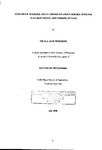BEHAVIOUR, WELFARE AND NUTRITION OF GROUP-HOUSED SOWS FED IN AN ELECTRONIC SOW FEEDING SYSTEM
| dc.contributor.author | HODGKISS, NICOLA JANE | |
| dc.contributor.other | Faculty of Science and Engineering | en_US |
| dc.date.accessioned | 2013-11-05T13:15:07Z | |
| dc.date.available | 2013-11-05T13:15:07Z | |
| dc.date.issued | 1998 | |
| dc.identifier | NOT AVAILABLE | en_US |
| dc.identifier.uri | http://hdl.handle.net/10026.1/2605 | |
| dc.description.abstract |
A programme of study was undertaken to assess the welfare status of multiparous gestating sows housed in dynamic groups in a straw yard and fed by electronic sow feeders (ESF). Comparison of production figures from the Seale-Hayne herd with those nationally confirmed its status as a typical commercial unit. In an initial series of investigations, detailed ethograms were compiled to describe the animals' repertoire of activities and interactions. Lying and straw manipulation were found to be the predominant behaviours and attacks directed towards the head were the most commonly performed type of interaction. Although there was little evidence of aggressive behaviour, most interactions were found to occur in areas where there was an obvious source of competition, namely the feeding and lying areas. A recording scale was devised to assess the level of skin damage arising from aggressive interactions. Whilst data revealed a relationship between parity and the extent of injury, both the frequency and intensity of injury were found to be low for all animals and there was very little evidence of vulva biting, commonly cited as a major criticism of group-housing systems. Animals were observed to rest predominantly in the lying area. There was an association between parity and resting location, with older animals occupying those areas perceived to be more favourable. Recently introduced gilts and sows were observed to integrate gradually with the main group. An argument is put forward for the existence of sub-groups based upon parity within the main group, although it was concluded that it was difficult to prove such a theory. A series of voluntary feed intake (VFI) trials revealed that the animals' feeding motivation was not satisfied by the allowance fed in gestation. Results from a trial when animals were offered a high fibre, low energy diet in comparison with their conventional feed suggested that the animals had a requirement for a certain level of energy and were not motivated simply by a desire for gut-fill. However, a subsequent investigation into the animals feeding behaviour did not reveal any evidence of a frustrated feeding motivation; there was little evidence of non-feeding visits and few animals were recorded in the feed queue throughout the day. It is concluded that sows can be group-housed in a dynamic system on a restricted feed intake without detriment to their welfare or productivity status. A number of factors were found to be critical to the success of such a system including the freedom for animals to behave as individuals, the regular provision of fresh straw and adequate space for newly introduced animals to integrate gradually with the herd. | en_US |
| dc.language.iso | en | en_US |
| dc.publisher | University of Plymouth | en_US |
| dc.title | BEHAVIOUR, WELFARE AND NUTRITION OF GROUP-HOUSED SOWS FED IN AN ELECTRONIC SOW FEEDING SYSTEM | en_US |
| dc.type | Thesis | |
| plymouth.version | Full version: final and full version as approved by the examiners at the time of the award of your degree | en_US |
| dc.identifier.doi | http://dx.doi.org/10.24382/1560 |
Files in this item
This item appears in the following Collection(s)
-
01 Research Theses Main Collection
Research Theses Main


